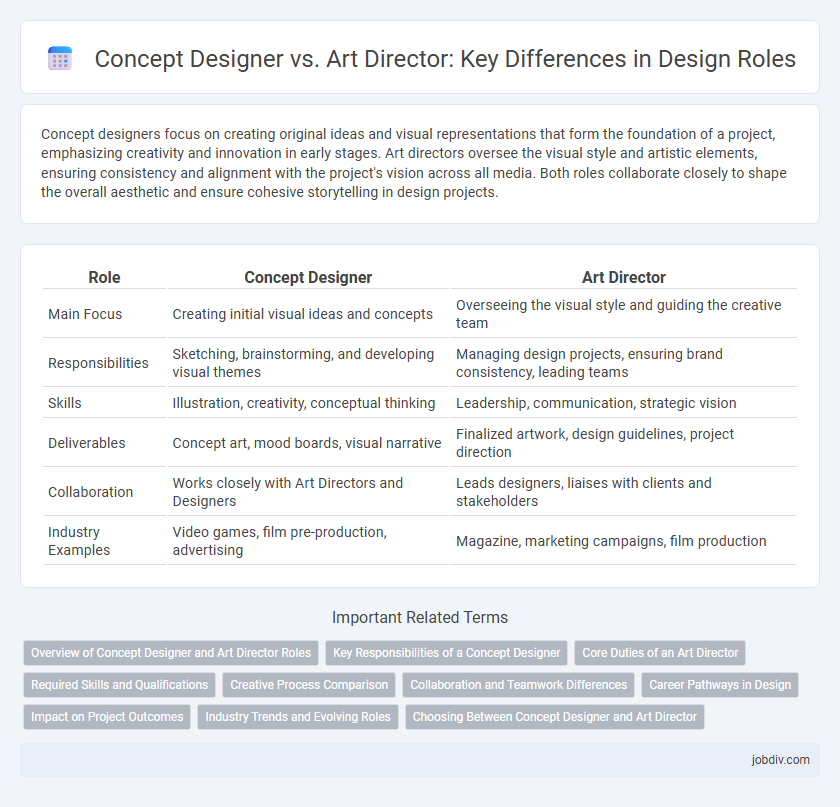Concept designers focus on creating original ideas and visual representations that form the foundation of a project, emphasizing creativity and innovation in early stages. Art directors oversee the visual style and artistic elements, ensuring consistency and alignment with the project's vision across all media. Both roles collaborate closely to shape the overall aesthetic and ensure cohesive storytelling in design projects.
Table of Comparison
| Role | Concept Designer | Art Director |
|---|---|---|
| Main Focus | Creating initial visual ideas and concepts | Overseeing the visual style and guiding the creative team |
| Responsibilities | Sketching, brainstorming, and developing visual themes | Managing design projects, ensuring brand consistency, leading teams |
| Skills | Illustration, creativity, conceptual thinking | Leadership, communication, strategic vision |
| Deliverables | Concept art, mood boards, visual narrative | Finalized artwork, design guidelines, project direction |
| Collaboration | Works closely with Art Directors and Designers | Leads designers, liaises with clients and stakeholders |
| Industry Examples | Video games, film pre-production, advertising | Magazine, marketing campaigns, film production |
Overview of Concept Designer and Art Director Roles
Concept Designers specialize in developing initial visual ideas and innovative concepts that guide the creative direction of a project, focusing on originality and detailed sketches. Art Directors oversee the overall aesthetic and visual style, managing creative teams to ensure cohesion and alignment with the project's goals and brand identity. Both roles are essential in the design process, with Concept Designers driving the creative foundation and Art Directors ensuring consistent execution across all visual elements.
Key Responsibilities of a Concept Designer
Concept Designers focus on creating innovative visual ideas and detailed sketches that form the foundation for product development, game design, or film production. They translate abstract ideas into tangible concepts by collaborating closely with creative teams and refining designs based on feedback. Their key responsibilities include ideation, producing concept art, and ensuring alignment with the project's vision and technical requirements.
Core Duties of an Art Director
An Art Director oversees the visual style and imagery in design projects, ensuring cohesive brand identity and creative vision across all media. They manage teams of designers, photographers, and illustrators, coordinating efforts to deliver high-quality visual content. Their responsibilities include approving final designs, setting budgets, and ensuring project timelines are met while maintaining artistic standards.
Required Skills and Qualifications
Concept Designers require strong skills in visual storytelling, creativity, and proficiency in digital illustration tools such as Adobe Photoshop and Illustrator, alongside a deep understanding of anatomy, perspective, and color theory to create original design concepts. Art Directors demand advanced leadership abilities, expertise in project management, and a comprehensive grasp of design principles, branding, and production processes, often requiring experience in coordinating cross-functional teams and ensuring cohesive visual styles. Both roles typically require a bachelor's degree in Graphic Design, Fine Arts, or related fields, with Concept Designers emphasizing artistic proficiency and innovative thinking, while Art Directors prioritize strategic vision and team collaboration.
Creative Process Comparison
Concept Designers prioritize ideation and visualization, crafting initial sketches and digital prototypes to explore innovative ideas and set the creative direction. Art Directors oversee the entire creative process, ensuring the cohesive execution of visual elements while managing teams and aligning designs with brand identity and project goals. This dynamic balance between innovation and oversight shapes a streamlined workflow from concept to final output.
Collaboration and Teamwork Differences
Concept Designers primarily focus on creating initial ideas and visualizing core elements, working closely with illustrators and modelers to ensure creative foundations are clear. Art Directors coordinate the broader visual style and maintain cohesive aesthetics across the project, guiding multiple teams to unify the artistic vision. Collaboration for Concept Designers is often detailed and iterative, while Art Directors emphasize cross-department communication and leadership to align all creative efforts.
Career Pathways in Design
Concept Designers specialize in creating initial visual ideas and prototypes that define the direction of a project, often working closely with creative teams to establish themes and styles. Art Directors oversee the visual elements of a project, managing design teams to ensure cohesive aesthetics and brand alignment across mediums. Career pathways typically begin with roles in graphic or visual design, advancing to Concept Designer positions, and with experience and leadership skills, progressing to Art Director roles that emphasize strategic vision and team management.
Impact on Project Outcomes
Concept Designers shape the visual foundation by developing innovative ideas and creative briefs that drive the project's aesthetic direction, ensuring alignment with client goals and market trends. Art Directors translate these concepts into cohesive visual narratives, overseeing style consistency, quality control, and collaboration across creative teams to enhance overall project execution. Together, their roles synergize to directly impact project outcomes through strategic creativity and meticulous visual management.
Industry Trends and Evolving Roles
Concept Designers increasingly leverage immersive technologies like AR and VR to create innovative visual narratives, reflecting industry trends toward experiential design. Art Directors focus on integrating multidisciplinary teams, balancing creative vision with strategic brand alignment in response to evolving demands for cohesive storytelling across digital platforms. Both roles adapt continually, emphasizing collaboration and technological fluency to meet shifting market expectations in the design landscape.
Choosing Between Concept Designer and Art Director
Choosing between a Concept Designer and an Art Director depends on project needs and creative direction. Concept Designers specialize in visualizing ideas and creating detailed preliminary designs, essential during early development stages. Art Directors oversee the overall visual style and coordinate creative teams to ensure cohesive execution across all design elements.
Concept Designer vs Art Director Infographic

 jobdiv.com
jobdiv.com